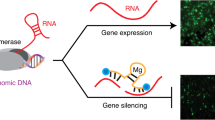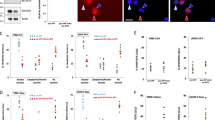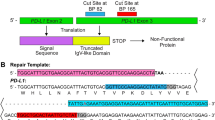Abstract
Stable expression of short-hairpin RNAs (shRNAs) directed against the X-linked inhibitor of apoptosis (XIAP) resulted in the generation of three MDA-MB-231 cell lines (XIAP shRNA cells) with reductions in XIAP mRNA and protein levels >85% relative to MDA-MB-231 cells stably transfected with the U6 RNA polymerase III promoter alone (U6 cells). This RNA interference (RNAi) approach dramatically sensitized these cells to killing by the tumor necrosis factor-related apoptosis-inducing ligand (TRAIL). Importantly, loss of XIAP also sensitized the cells to killing by taxanes but had no additional effects on killing by carboplatin and doxorubicin. The increased sensitivity of the XIAP shRNA cells to killing by TRAIL and taxanes correlated with enhanced caspase cleavage and activation, including caspase-8, and robust processing of poly(ADP-ribose) polymerase and BID compared to U6 cells. Additionally, increasing XIAP levels by adenovirus-mediated expression protected both XIAP shRNA and U6 cells from TRAIL killing in a dose-dependent manner. The effects observed by stable RNAi with respect to TRAIL sensitization were also achieved following downregulation of XIAP in Panc-1 cells treated with a second-generation, mixed-backbone antisense oligonucleotide, AEG 35156/GEM640. These data indicate that reducing XIAP protein expression by either RNAi or antisense approaches increases cancer cell susceptibility to functionally diverse chemotherapeutic agents and supports the notion that downregulation of XIAP in vivo may synergize with disease-relevant chemotherapeutic regimes, including TRAIL and taxanes, to increase the effectiveness of antineoplastic agents.
This is a preview of subscription content, access via your institution
Access options
Subscribe to this journal
Receive 50 print issues and online access
$259.00 per year
only $5.18 per issue
Buy this article
- Purchase on Springer Link
- Instant access to full article PDF
Prices may be subject to local taxes which are calculated during checkout










Similar content being viewed by others
References
Agrawal S, Jiang Z, Zhao Q, Shaw D, Cai Q, Roskey A, Channavajjala L, Saxinger C and Zhang R . (1997). Proc. Natl. Acad. Sci. USA, 94, 2620–2625.
Alnemri ES, Livingston DJ, Nicholson DW, Salvesen G, Thornberry NA, Wong WW and Yuan J . (1996). Cell, 87, 171.
Ambrosini G, Adida C and Altieri DC . (1997). Nat. Med., 3, 917–921.
Aouad SM, Cohen LY, Sharif-Askari E, Haddad EK, Alam A and Sekaly RP . (2004). J. Immunol., 172, 2316–2323.
Bilim V, Kasahara T, Hara N, Takahashi K and Tomita Y . (2003). Int. J. Cancer, 103, 29–37.
Bridge AJ, Pebernard S, Ducraux A, Nicoulaz AL and Iggo R . (2003). Nat. Genet., 34, 263–264.
Carter BZ, Kornblau SM, Tsao T, Wang RY, Schober WD, Milella M, Sung HG, Reed JC and Andreeff M . (2003). Blood, 102, 4179–4186.
Chai J, Shiozaki E, Srinivasula SM, Wu Q, Datta P, Alnemri ES, Shi Y and Dataa P . (2001). Cell, 104, 769–780.
Chawla-Sarkar M, Bae SI, Reu FJ, Jacobs BS, Lindner DJ and Borden EC . (2004). Cell Death Differ., 30, 1–9.
Cory S and Adams JM . (2002). Nat. Rev. Cancer, 2, 647–656.
Cummings BS, Kinsey GR, Bolchoz LJ and Schnellmann RG . (2004). J. Pharmacol. Exp. Ther., 310, 126–134.
Cummins JM, Kohli M, Rago C, Kinzler KW, Vogelstein B and Bunz F . (2004). Cancer Res., 64, 3006–3008.
Deveraux QL, Roy N, Stennicke HR, Van Arsdale T, Zhou Q, Srinivasula SM, Alnemri ES, Salvesen GS and Reed JC . (1998). EMBO J., 17, 2215–2223.
Deveraux QL, Takahashi R, Salvesen GS and Reed JC . (1997). Nature, 388, 300–304.
Du C, Fang M, Li Y, Li L and Wang X . (2000). Cell, 102, 33–42.
Dykxhoorn DM, Novina CD and Sharp PA . (2003). Nat. Rev. Mol. Cell Biol., 4, 457–467.
Giodini A, Kallio MJ, Wall NR, Gorbsky GJ, Tognin S, Marchisio PC, Symons M and Altieri DC . (2002). Cancer Res., 62, 2462–2467.
Hegde R, Srinivasula SM, Datta P, Madesh M, Wassell R, Zhang Z, Cheong N, Nejmeh J, Fernandes-Alnemri T, Hoshino S and Alnemri ES . (2003). J. Biol. Chem., 278, 38699–38706.
Hegde R, Srinivasula SM, Zhang Z, Wassell R, Mukattash R, Cilenti L, DuBois G, Lazebnik Y, Zervos AS, Fernandes-Alnemri T and Alnemri ES . (2002). J. Biol. Chem., 277, 432–438.
Heid CA, Stevens J, Livak KJ and Williams PM . (1996). Genome Res., 6, 986–994.
Holcik M and Korneluk RG . (2001). Nat. Rev. Mol. Cell Biol., 2, 550–556.
Holcik M, Lefebvre CA, Hicks K and Korneluk RG . (2002). BMC Genom., 3, 1–5.
Hsu CK, Rishi AK, Li XS, Dawson MI, Reichert U, Shroot B and Fontana JA . (1997). Exp. Cell Res., 232, 17–24.
Hu Y, Cherton-Horvat G, Dragowska V, Baird S, Korneluk RG, Durkin JP, Mayer LD and LaCasse EC . (2003). Clin. Cancer Res., 9, 2826–2836.
Huang Y, Park YC, Rich RL, Segal D, Myszka DG and Wu H . (2001). Cell, 104, 781–790.
LaCasse EC, Baird S, Korneluk RG and MacKenzie AE . (1998). Oncogene, 17, 3247–3259.
Liston P, Fong WG, Kelly NL, Toji S, Miyazaki T, Conte D, Tamai K, Craig CG, McBurney MW and Korneluk RG . (2001). Nat. Cell Biol., 3, 128–133.
Liston P, Fong WG and Korneluk RG . (2003). Oncogene, 22, 8568–8580.
Liston P, Young SS, Mackenzie AE and Korneluk RG . (1997). Apoptosis, 2, 423–441.
Lo YM, Wong IH, Zhang J, Tein MS, Ng MH and Hjelm NM . (1999). Cancer Res., 59, 3899–3903.
Nomura T, Mimata H, Takeuchi Y, Yamamoto H, Miyamoto E and Nomura Y . (2003). Urol. Res., 31, 37–44.
Paddison PJ, Caudy AA, Bernstein E, Hannon GJ and Conklin DS . (2002). Genes Dev., 16, 948–958.
Pardo OE, Lesay A, Arcaro A, Lopes R, Ng BL, Warne PH, McNeish IA, Tetley TD, Lemoine NR, Mehmet H, Seckl MJ and Downward J . (2003). Mol. Cell. Biol., 23, 7600–7610.
Reed JC . (2003). Cancer Cell, 3, 17–22.
Riedl SJ, Renatus M, Schwarzenbacher R, Zhou Q, Sun C, Fesik SW, Liddington RC and Salvesen GS . (2001). Cell, 104, 791–800.
Roy N, Deveraux QL, Takahashi R, Salvesen GS and Reed JC . (1997). EMBO J., 16, 6914–6925.
Sasaki H, Sheng Y, Kotsuji F and Tsang BK . (2000). Cancer Res., 60, 5659–5666.
Schimmer AD, Welsh K, Pinilla C, Wang Z, Krajewska M, Bonneau MJ, Pedersen IM, Kitada S, Scott FL, Bailly-Maitre B, Glinsky G, Scudiero D, Sausville E, Salvesen G, Nefzi A, Ostresh JM, Houghten RA and Reed JC . (2004). Cancer Cell, 5, 25–35.
Shi J, Zheng D, Man K, Fan ST and Xu R . (2003). Curr. Mol. Med., 3, 727–736.
Shi Y . (2002). Mol. Cell, 9, 459–470.
Shin S, Sung BJ, Cho YS, Kim HJ, Ha NC, Hwang JI, Chung CW, Jung YK and Oh BH . (2001). Biochemistry, 40, 1117–1123.
Simons M, Beinroth S, Gleichmann M, Liston P, Korneluk RG, MacKenzie AE, Bahr M, Klockgether T, Robertson GS, Weller M and Schulz JB . (1999). J. Neurochem., 72, 292–301.
Sledz CA, Holko M, de Veer MJ, Silverman RH and Williams BR . (2003). Nat. Cell Biol., 5, 834–839.
Stennicke HR, Ryan CA and Salvesen GS . (2002). Trends Biochem. Sci., 27, 94–101.
Suzuki Y, Imai Y, Nakayama H, Takahashi K, Takio K and Takahashi R . (2001). Mol. Cell, 8, 613–621.
Takahashi R, Deveraux Q, Tamm I, Welsh K, Assa-Munt N, Salvesen GS and Reed JC . (1998). J. Biol. Chem., 273, 7787–7790.
Tamm I, Kornblau SM, Segall H, Krajewski S, Welsh K, Kitada S, Scudiero DA, Tudor G, Qui YH, Monks A, Andreeff M and Reed JC . (2000). Clin. Cancer Res., 6, 1796–1803.
Tillman DM, Izeradjene K, Szucs KS, Douglas L and Houghton JA . (2003). Cancer Res., 63, 5118–5125.
Tsujimoto Y, Cossman J, Jaffe E and Croce CM . (1985). Science, 228, 1440–1443.
van Loo G, van Gurp M, Depuydt B, Srinivasula SM, Rodriguez I, Alnemri ES, Gevaert K, Vandekerckhove J, Declercq W and Vandenabeele P . (2002). Cell Death Differ., 9, 20–26.
Verhagen AM, Ekert PG, Pakusch M, Silke J, Connolly LM, Reid GE, Moritz RL, Simpson RJ and Vaux DL . (2000). Cell, 102, 43–53.
Vilenchik M, Raffo AJ, Benimetskaya L, Shames D and Stein CA . (2002). Cancer Res., 62, 2175–2183.
von Haefen C, Wieder T, Essmann F, Schulze-Osthoff K, Dorken B and Daniel PT . (2003). Oncogene, 22, 2236–2247.
Wagenknecht B, Glaser T, Naumann U, Kugler S, Isenmann S, Bahr M, Korneluk R, Liston P and Weller M . (1999). Cell Death Differ., 6, 370–376.
Weller M, Malipiero U, Aguzzi A, Reed JC and Fontana A . (1995). J. Clin. Invest., 95, 2633–2643.
Yang J, Liu X, Bhalla K, Kim CN, Ibrado AM, Cai J, Peng TI, Jones DP and Wang X . (1997). Science, 275, 1129–1132.
Yang L, Cao Z, Yan H and Wood WC . (2003). Cancer Res., 63, 6815–6824.
Zhang XD, Zhang XY, Gray CP, Nguyen T and Hersey P . (2001). Cancer Res., 61, 7339–7348.
Acknowledgements
DCM is supported by Industrial Research Fellowship from the National Sciences and Engineering Research Council of Canada. We thank Dr Peter Liston for valuable discussions and help in setting up the cell-free caspase activity assays.
Author information
Authors and Affiliations
Corresponding author
Rights and permissions
About this article
Cite this article
McManus, D., Lefebvre, C., Cherton-Horvat, G. et al. Loss of XIAP protein expression by RNAi and antisense approaches sensitizes cancer cells to functionally diverse chemotherapeutics. Oncogene 23, 8105–8117 (2004). https://doi.org/10.1038/sj.onc.1207967
Received:
Revised:
Accepted:
Published:
Issue Date:
DOI: https://doi.org/10.1038/sj.onc.1207967
Keywords
This article is cited by
-
Co-expression of XIAP and CIAP1 Play Synergistic Effect on Patient’s Prognosis in Head and Neck Cancer
Pathology & Oncology Research (2019)
-
Concomitance of downregulated active caspase-3 and upregulated X-chromosome linked inhibitor of apoptosis protein as a sensitive diagnostic approach for breast cancer
Molecular and Cellular Biochemistry (2019)
-
microRNA-137 promotes apoptosis in ovarian cancer cells via the regulation of XIAP
British Journal of Cancer (2017)
-
Overcoming chemotherapy drug resistance by targeting inhibitors of apoptosis proteins (IAPs)
Apoptosis (2017)
-
The Gβ5 protein regulates sensitivity to TRAIL-induced cell death in colon carcinoma
Oncogene (2015)



